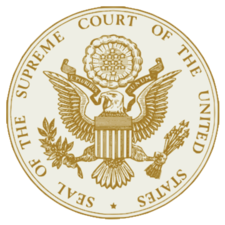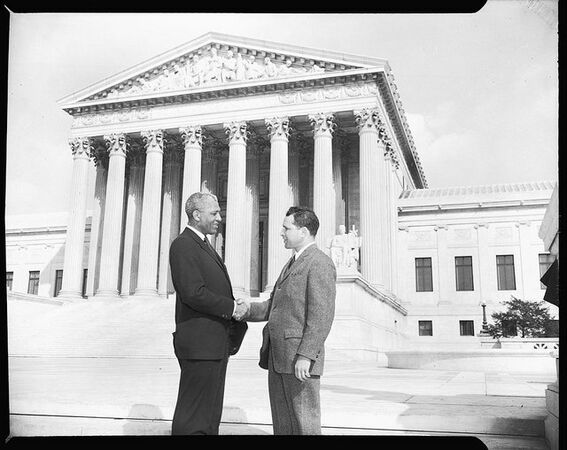Monasky v. Taglieri
 | |
| Monasky v. Taglieri | |
| Term: 2019 | |
| Important Dates | |
| Argument: December 11, 2019 Decided: February 25, 2020 | |
| Outcome | |
| Affirmed | |
| Vote | |
| 9-0 | |
| Majority | |
| Chief Justice John G. Roberts • Clarence Thomas • Ruth Bader Ginsburg • Stephen Breyer • Samuel Alito • Sonia Sotomayor • Elena Kagan • Neil Gorsuch • Brett Kavanaugh | |
| Concurring | |
| Clarence Thomas • Samuel Alito | |
Monasky v. Taglieri is a case argued before the Supreme Court of the United States on December 11, 2019, during the court's October 2019-2020 term. The case concerned the standard of review for "habitual residence" and how to establish "habitual residence" for purposes of the Hague Convention on the Civil Aspects of International Child Abduction. The case came on a writ of certiorari to the United States Court of Appeals for the 6th Circuit.
The court affirmed the 6th Circuit's decision in a unanimous ruling, holding (1) an actual agreement between the parents on where to raise a child is not necessary to establish the child's habitual residence and (2) a district court should use clear-error review to determine habitual residence under the Hague Convention.[1] Click here for more information.
You can review the lower court's opinion here.
Timeline
The following timeline details key events in this case:
- February 25, 2020: The U.S. Supreme Court affirmed the 6th Circuit's ruling.
- December 11, 2019: Oral argument
- June 10, 2019: The U.S. Supreme Court agreed to hear the case.
- January 15, 2019: Michelle Monasky filed a petition with the U.S. Supreme Court.
- October 17, 2018: The 6th Circuit affirmed the ruling of the Northern District of Ohio.
Background
Domenico Taglieri, an Italian, and Michelle Monasky, an American, were married. In February 2015, they had a daughter, A.M.T. In March 2015, Monasky told Taglieri she wanted to get a divorce and move to the United States. Around that time, Monasky and Taglieri both began applications for Italian and American passports for A.M.T.[2]
After an argument in late March 2015, Monaksy took A.M.T. to the police, seeking shelter in a safe house and alleging Taglieri was abusive. After Taglieri found Monasky and A.M.T. gone from their home, he went to the police and revoked his permission for A.M.T.'s U.S. passport. Two weeks later, Monasky took A.M.T. to the United States.[2]
Taglieri filed an action in Italian court to end Monasky's parental rights. The court ruled in Taglieri's favor. Taglieri then petitioned the United States District Court for the Northern District of Ohio, seeking A.M.T's return to Italy under the Hague Convention. The district court granted Taglieri's petition. Monasky appealed. The United States Court of Appeals for the 6th Circuit and the Supreme Court of the United States denied Monasky's motion for a stay pending appeal and A.M.T. was returned to Italy.[2]
On appeal, a divided panel of the 6th Circuit affirmed the district court's ruling. The court, sitting en banc, again affirmed the district court.[2] According to the petition Monasky filed with the U.S. Supreme Court, the 6th Circuit's ruling "deepened an existing circuit split on the standard of review to be applied to a district court’s habitual-residence determination."[4]
Monasky petitioned the U.S. Supreme Court for an appeal.[4] On June 10, 2019, the U.S. Supreme Court accepted.
Hague Convention on the Civil Aspects of International Child Abduction
The Hague Conference on Private International Law unanimously adopted the Convention on the Civil Aspects of International Child Abduction in 1980. The convention's purpose was "to secure the prompt return of children who have been abducted from their country of habitual residence or wrongfully retained outside that country."[4]
According to the petition Monasky filed, "The Hague Convention on the Civil Aspects of International Child Abduction requires that any child wrongfully removed from her country of 'habitual residence' be returned to that country."[4]
Questions presented
The petitioner presented the following questions to the court:
| Questions presented: (1) Whether a district court's determination of habitual residence under the Hague Convention should be reviewed 'de novo', as seven circuits have held, under a deferential version of de novo review, as the First Circuit has held, or under clear-error review, as the Fourth and Sixth Circuits have held. |
Outcome
In a unanimous opinion, the U.S. Supreme Court affirmed the judgment of the 6th Circuit Court of Appeals. The SCOTUS justices held (1) an actual agreement between the parents on where to raise a child is not necessary to establish the child's habitual residence and (2) a district court should use clear-error review to determine habitual residence under the Hague Convention.
Justice Ruth Bader Ginsburg delivered the opinion of the court. Justice Clarence Thomas joined as to Parts I, III and IV, and filed an opinion concurring in part and concurring in the judgment. Justice Samuel Alito filed an opinion concurring in part and concurring in the judgment.
Opinion
In her opinion, Justice Ginsburg wrote of the first question presented:[1]
| “ | The first question presented concerns the standard for habitual residence: Is an actual agreement between the parents on where to raise their child categorically necessary to establish an infant’s habitual residence? We hold that the determination of habitual residence does not turn on the existence of an actual agreement. ... |
” |
Justice Ginsburg wrote of the second question presented, "The habitual-residence determination thus presents a task for factfinding courts, not appellate courts, and should be judged on appeal by a clear-error review standard deferential to the factfinding court."[1]
Concurring opinion
Justice Thomas
Justice Thomas filed an opinion concurring in part and concurring in the judgment.[1]
In his concurring opinion, Thomas wrote:
| “ | The Court correctly concludes that an actual agreement between parents is not necessary to establish the habitual residence of an infant who is too young to acclimatize.* I also agree with the Court’s conclusion that the habitual residence inquiry is intensely fact driven, requiring courts to take account of the unique circumstances of each case. I write separately, however, because I would decide this case principally on the plain meaning of the treaty’s text.[5] | ” |
Justice Alito
Justice Alito filed an opinion concurring in part and concurring in the judgment.[1]
In his concurring opinion, Alito wrote:
| “ | I agree with the Court on almost all the issues in this case. Specifically, I agree (1) that analysis of the question of 'habitual residence' should be based on a range of factors and should be attentive to the particular facts of each case, (2) that a child may have a habitual residence in a country without a parental agreement to that effect, (3) that our interpretation of habitual residence should take into account the interpretations of other signatory nations, (4) that a district court’s decision on habitual residence is entitled to deference on appeal, and (5) that the judgment below should be affirmed. I also agree with JUSTICE THOMAS that we must independently interpret the meaning of 'habitual residence.'[5] | ” |
Text of the opinion
Read the full opinion here.
Oral argument
Audio
Audio of oral argument:[6]
Transcript
See also
External links
- U.S. Supreme Court docket file - Monasky v. Taglieri (petitions, motions, briefs, opinions, and attorneys)
- SCOTUSblog case file for Monasky v. Taglieri
Footnotes
- ↑ 1.0 1.1 1.2 1.3 1.4 1.5 Supreme Court of the United States, Monasky v. Taglieri, decided February 25, 2020
- ↑ 2.0 2.1 2.2 2.3 2.4 United States Court of Appeals for the 6th Circuit, Taglieri v. Monasky, decided October 17, 2018
- ↑ 3.0 3.1 Supreme Court of the United States, "Questions presented: 18-935 Monasky v. Taglieri," accessed June 11, 2019
- ↑ 4.0 4.1 4.2 4.3 Supreme Court of the United States, "Petition for a writ of certiorari," accessed June 11, 2019
- ↑ 5.0 5.1 5.2 Note: This text is quoted verbatim from the original source. Any inconsistencies are attributable to the original source.
- ↑ Supreme Court of the United States, "Oral Argument - Audio," accessed December 16, 2019
| |||||||||||












